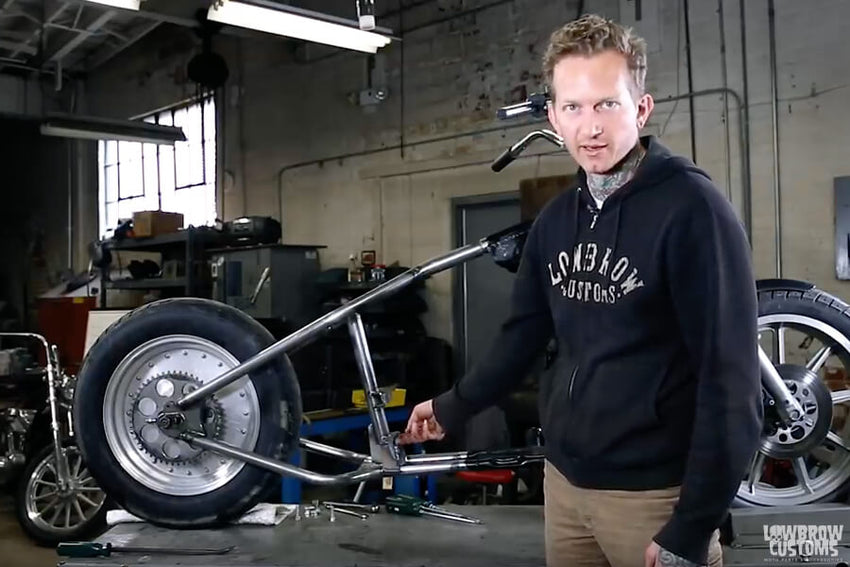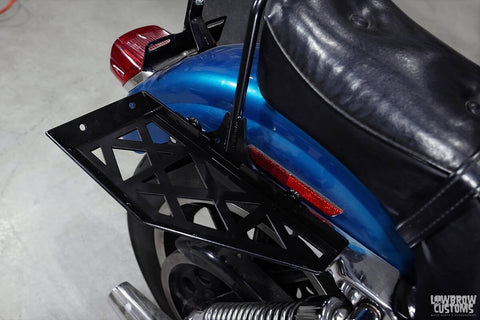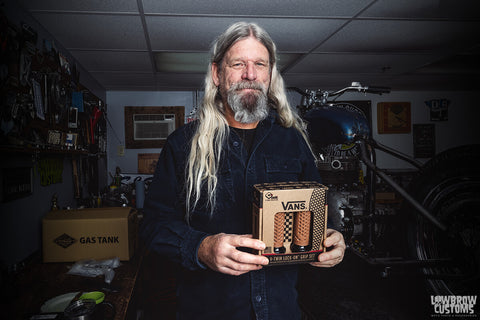In this step by step how-to tutorial, Tyler with the help of his stunt double Tim, walk you through how easy it is to install our Lowbrow Customs Sportster Hardtail Frame section for 1982-03 Harley-Davidson Sportsters.
In an afternoon in your garage you can change the entire look of your Sportster and give yourself a good canvas to start your killer chopper or bobber project, especially with the help of all the custom Sportster parts Lowbrow makes and sells, including options for a Harley hardtail frame!
WATCH VIDEO: HOW TO INSTALL A HARLEY SPORTSTER HARDTAIL FRAME
Check out the Lowbrow Customs YouTube channel to check out all of our videos. We spend a lot of time and effort creating motorcycle how-to videos, product reviews and event coverage for your enjoyment, please let us know what you think by commenting below.
Click here to subscribe to the Lowbrow Customs YouTube channel and stay in the know!
Check our other hardtail projects installing on the Harley Sportster below:
- INSTALLING A 1954 - 1972 SPORTSTER DAVID BIRD HARDTAIL
- INSTALLING A DAVID BIRD 1973 - 1978 SPORTSTER HARDTAIL FRAME
- INSTALLING A DAVID BIRD 1979 - 1981 SPORTSTER HARDTAIL FRAME
You can read a full transcription of this video below:
Hey, it's Tyler with Lowbrow Customs. Today we're going to show you how to install one of these hardtails which are for '82 to 2003 Sportsters under this bike. This one's a 1988. It's quick and easy, follow along with us and you can have this done in an afternoon very easily.
The bike has it sits, is pretty much ready how you should have your bike prepared. It's a hard talent. Basically removed everything, all the main components. The last things are the wheel and front end, you can leave them on at this point or you can have those off and just have your rigid rear frame and motor preference. The first thing that we're going to do is pull the motor out of the frame so we can measure and cut the frame. If you've got a front motor mount, top motor mount, those can be unbolted completely removed, and then the motor unbolts at the front and rear and we're going to pull it completely out of the frame.
We've got all of the hardware removed, all the motor mount plates removed. This motor is just sitting here on the spacers and will be on the cradle here. To pull this out of the frame, it's going to come out of the right side. We're going to grab this and shift it forward very slightly to release the rear, and then I'll tip it toward myself, throw it on the table. I may have a block of wood ready to support the front so the motor doesn't fall over. That's about it. Now that the motor's out of the frame, I'm going to show you where to pull measurements from to scribe your frame, your stock frame. I'll show you where to cut.
The hardtail's already slugged. These are machined solid slugs here on the lower rails and a piece of tubing on the top which allows you to run internal wiring through your backbone if you desire. When you cut this, what we're going to do is we're going to mark it out and cut it and then go ahead and grind the tubes to make sure they're totally flat. What we're going to really aim for once it's ground and everything's nice and square is about an eighth-inch gap between the stock lower frame rail tubing and the tubing of the hardtail. That gap, roughly an eighth inch, when you weld, it's going to allow good penetration on the slug as well as both tubes, so all three pieces can be a really nice strong weld.
You've got some leeway here. If you cut, you grind a little too much or something and it's a quarter inch gap, that's fine, it's not going to be a strength or structural issue whatsoever. Really, all these joints get hidden with the motor and gas tank on, so you've got a little leeway on these measurements. The first measurement I'm going to pull here, I'll show you how it corresponds to the hardtail. This flat plate here at the rear motor mount is the same measurement as far as in relation to the motor as the face of these bungs here on the rear motor mount. What I'm going to do is just pull a measurement using a square, it's just a common square you can get anywhere.
I'm going to go ahead and keep the lower run parallel to the tube and just butt it right against the corner of that block there. You can see pretty clear it's right at six inches to the end of this tube. What we need to do on the stock frame, and it's a little different with the way the rails are in such a bend here, but you're going to butt the square against the face of that bump. Pull this ruler so it's parallel to the lower frame rail, and then the easiest way to do this is just to scribe a mark right into your paint. Right here at the sixth-inch mark, I just went ahead and did a little scribe. You can go ahead and deepen that.
I'll go ahead and do the same thing on the other side. For the upper mount, we're going to pull a dimension coming from the rear of the top motor mount bracket right where it meets the frame, and that's going to be a nine-sixteenth back on this top tube. For that, you can use just a standard ruler, it's a little machinist scale. I'm just going to go ahead and line it up and the same thing, I'm just going to scribe it at nine-sixteenths, move the ruler, deepen it. You do want to hold this parallel to the tube to get an accurate measurement. I went ahead and inscribed a little line there, nine-sixteenths, I'll mark that other side, and I will probably pull the rear wheel off before we cut this just to make it a little easier.
All right, so the rear wheel's off, this thing's ready to cut. We're going to go ahead and cut the rear section of the frame off. We're using a Sawzall for the job, this works great. You could also use a grinder with the cut-off wheel, a hacksaw, whatever you prefer. All right, let's cut it.
There we go. I'm ready to slip the hardtail in once we clean up and debug the inside of these holes. We're going to go ahead and drill through the lower and upper frame rail to get some rosette welds once that new hardtail is slipped in. The rear spacers are strapped so there's no way those can move, but the top piece is a tube and the rosette weld will hold that in place and offer a little stability while we go ahead and weld around the tubes. Let's do it.
All right, so we cross-drilled through both lower rails, which that'll be used to rosette weld the slug to the tube before we weld around there. Also, cross-drilled the top the backbone and put a chamfer around the outside edge of all of these tubes. That make sure you get really good weld penetration between both pieces of tubing and this bug, and you just do that with anything, a grinder, a flat disc, whatever. The other thing we did was clean up inside of the tubing here. This was actually, being a bit of an older frame, pretty rusty and crusty.
You can use a die grinder with a barrel sander like that and then work around in there. Make sure you get in for the full depth of the sleeves or a little flap disc will work. The die grinder bit, pretty much a little bird bit. Anything you can to clean that up in there. Then you can test fit this. Because these are going in at different angles, usually you've got to use a rubber mallet to send this home, but if you're just going to offset it, you can test and see that that goes fully seated home on both sides, and then tilt this. There you go, the backbone so it all slides in so we know these holes are all open and there's no restriction there.
To send this home, what you're going to want to do is use a rubber mallet, varying sizes, whatever you need, the big one right here. Don't beat on this with a metal hammer or a ball-peen or anything. What we're going to do is go ahead and line these up and I'm going to probably smack right here with a rubber mallet and get these started sliding in there. There can be a little bit of tension depending on the display of the frame rails here. It's usually I'd use a mallet to tap it in. One thing we noticed on here is when I go to line these lower slugs up, the stock frame is just a hair wider, sprung a little wider than the hardtail, so you do something simple like this clamp and just give it a little bit of tension.
Adjust it so these are just the right width. There we go. It's sliding right in. The reason the mallet comes into play is because you've got conflicting angles on this plane and this plane. Typically, you're going to need to give it a few whacks to get this seated. We've got the hardtail slid in place through the rear wheel on it just to support it, and got together our hardware and the tools needed. What we're going to do is I'm going to grab the engine, get it into position getting an exact opposite of how we pulled it out as far as tipping it in, getting the sump in between the rails, and then sliding it back so the dowels engage the holes here on the rear motor mount plate.
It's handy to have another set of hands around, so while I'm holding the motor, Tim can get the hardware started in place. We're going to go ahead and bolt the motor up to all the different stock points and then to the rear here. That motor is going to serve as our fixture for tack welding the frame. It's going to ensure that we have a proper fit with the engine. You don't want to go ahead and just weld this thing up because your motor will probably not fit. All right. Tip it towards you and then you got to lift up.
Yes, that means we go upwards. There we go. With the help of Tim, the pry bar got the engine located there, and so now I'm just holding it steady while he gets the hardware started, and then we'll go around and just bolt it all up, tighten it up. The motor is back in the frame and we went ahead and installed all of the motor mounts and hardware. Don't skip this step, don't try and save yourself two minutes by only partially bolting stuff in. All hardware are on the rear mounts, you got your top motor mount bolt to the frame, you got your front plates, and then this upper front mount as well. Again, it's just this is all the stock mounting hardware.
This is shorter mounting bolts, but the same idea, everything is bolted up, torqued into place. You might have to rock your motor a little getting these bolts all situated, but it's pretty straightforward. Again, do not get the hardtail fit up and just weld or tack or anything, your engine serves as the jig for this hardtail. This is imperative, it's the most important thing you can do to not screw up your hardtail install. Bolt this in like we did. Now it's sitting right where it needs to be and the next step is going to be putting some solid tack welds. We're going to TIG weld this.
In our case, it's going to be we can just leave this uncovered, TIG welding doesn't throw sparks. If you're MIG welding, you might want to cover your motor or whatever, that's up to you. We're going to go ahead and throw some nice heavy tacks probably a few are on the top and two or three around the bottom. Then next up what we would typically do is finish weld everything possible with the bike as it sits, and then we will end up pulling the motor back out of the frame for the final finish welding and that's it. That seem to be the job, so we'll get welding.
All right, there we go. That's basically it for this hardtail installation. We're not going to bother showing you on film, but we're going to pull the motor back out and then weld to the areas we couldn't get to with the motor installed. If necessary, you could flip it on its side. If you pull the front end and the wheel off, it's really easy, you can turn it any way you want. Basically, you're just going to finish weld everything up there and you're ready to move onto the next phase of your project. If you liked this video, you can click follow below and you'll see all the latest videos from Lowbrow Customs. We're constantly filming new how-tos, event coverage all kinds of great stuff.
You can pick up your own hardtail at lowbrowcustoms.com, and if there's questions, comments, anything you want to say, say it in the comments below and we'll be sure to read them and respond to you. Thanks so much for watching.
Related Products
















